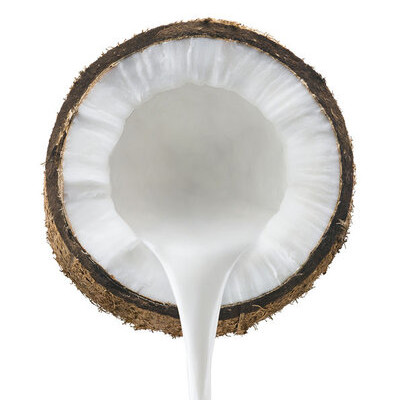
Coconut Milk
What is Coconut Milk?
Coconut milk is a flavorful rich liquid made from pressed fresh, matured coconut flesh. It has a characteristic flavor and color, and can be used as a lactose-free alternative to cow’s milk.1,2
In baking, this milk is used in formulating a variety of baked goods, sauces, fillings, desserts, pudding and toppings. 1,2 Several varieties commercially available include: 1
- Unsweetened
- Skim (0 -1.5 % fat)
- Low fat (5 – 10 % fat)
- Medium fat (10- 15 % fat)
- High fat (15 – 20 % fat)
Origin
Coconut palm (Cocos nucifera L) is a tree that originated in Asian tropics and expanded into many subtropical regions.2 The fruit and its milk are consumed by many populations.
Today, coconut milk is a staple in several Indian and Southeast Asian countries. Its nutritional benefits helped it spread into other cuisines.2
Function
This plant-based milk has several functions in baked products:3
- Flavor: provide a characteristic rich coconut flavor.
- Color: the protein undergoes browning via Maillard reaction.
- Delay staling
- Softness: due to the proteins and sugars water absorption capacity.
- Texture: provides a rich thick texture especially the high fat variety.
Nutrition
Typical nutritional profile:2
| Component | Percentage (%) |
|---|---|
| Moisture | 73.47 – 76.84 |
| Fat | 18.83 – 21.09 |
| Protein | 2.14 – 2.97 |
| Ash | 0.63 – 0.96 |
| Total Sugars | 0.82 – 1.62 |
Commercial production
Consumption of coconut milk is associated with several health benefits such as potential anti-diabetic and immunostimulatory activities.2
This milk is produced through the following process:2
- Dehusk and deshell: the outer brown layer is removed from the white kernel by mechanical means.
- Washing: the kernel is then washed with water to remove residues.
- Draining: to remove excess water.
- Grating: kernels are grated into flakes by industrial-scale cutters and grinders.
- Pressing: the flakes are screw-pressed to extract the rich milk liquid. A second water-aided pressing is done to increase extraction yield.
- Filtration: the milk is filtered .
- Standardization: water can be added or removed to produce a product with a certain fat level.
- Pasteurization: the milk is heated up to 72 oC (161 oF) .
- Packaging: the milk is aseptically filled and packaged for transportation.
Application
Coconut milk is used in several lactose-free baking recipes. Several considerations should be taken into account when incorporating this ingredient:4
- Medium and low fat milk can substitute milk at a 1:1 ratio.
- High fat milk has a thicker consistency. So, it should be diluted with water to provide a similar texture to cow’s milk.
- In lactose-free whipped cream, only the top fat layer of high fat milk can be used.
- Coconut milk yogurt is made from skimmed milk adjusted to various fat levels depending on desired texture.
- Coconut yogurt can replace sour cream in baked goods recipes at a 1:1 ratio.
Regulations
Coconut is considered GRAS by the FDA. Coconut milk is listed under fruit juices and is subject to FDA regulations.5
In the EU, milk is considered safe and its production must follow CODEX Alimentarius Guidelines.6
References
- NIIR Board of Consultants and Engineers.The Complete Book On Coconut & Coconut Products (Cultivation And Processing): How To Start A Coconut Farming And Processing?, How To Start A Coconut Oil Production, How To Start A Coconut Plantation, How To Start A Coconut Production Business, How To Start A Successful Coconut Processing. 2nd ed., ASIA PACIFIC BUSINESS PRESS Inc., 2012.
- Tetra Pak International.Coconut Handbook. GB: Tetra Pak International S.A, 2021.
- Figoni, P. How Baking Works: Exploring The Fundamentals Of Baking Science. 3 rd ed., John Wiley & Sons, Inc., 2011.
- Martin, Colette. Learning to Bake Allergen-free: A Crash Course for Busy Parents on Baking Without Wheat, Gluten, Dairy, Eggs, Soy Or Nuts. The Experiment, 2012.
- Food and Drug Administration (FDA). US Department of Health and Human Services.Guidance for Industry: Questions and Answers on Juice HACCP Regulation, https://www.fda.gov/regulatory-information/search-fda-guidance-documents/guidance-industry-questions-and-answers-juice-haccp-regulation-2003 , Accessed 27 February 2021
- FAO/OMS. Codex Alimentarius: Standard For Aqueous Coconut Products (Coconut Milk and Coconut Cream).CXS 240-2003, 2003.

